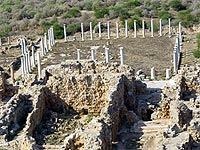
Royal Tombs in Famagusta, North Cyprus.
 |
the north cyprus travel guide |
 |
|
Royal Tombs
The Royal Tombs and Necropolis of Salamis, North CyprusRight opposite the site of the ancient city of Salamis in North Cyprus are the burial grounds for the city, spanning some 7 square kilometres. Many of the Royal Tombs in the Necropolis of Salamis have yielded important archaeological fin, but the most interesting tombs lie just 1km from the main land gate into Salamis. The Royal Tombs at Salamis, North CyprusThe most exciting tomb discoveries at the Royal Tombs at Salamis seem to show that the ancient story about the city of Salamis being founded by Greek heroes returning from the Trojan War might just be true! The 150 tombs discovered here were arranged exactly as the ancient writer Homer described in his great book about the Trojan War, the “Iliad”. Homer describes how the funeral pyres of the heroes were stacked with jars of oil and honey, and topped with four horses, and the funeral pyres at Salamis were built in exactly the same way! How Old are the Royal Tombs at Salamis, North Cyprus?The tombs, constructed in the 7th and 8th centuries BC were actually built over 500 years after the events of the Trojan War. However, the ancient funeral practices had clearly lived on. Many fascinating finds were made during the excavations of the Royal Tombs at Salamis, such as an ivory-inland throne and bed, plus numerous objects in precious metals and ivory. In Tomb 1, a necklace and sheets of gold used for decoration were discovered in the tomb, probably occupied by a Cypriot princess. All the tomb finds are now in the Cyprus Museum. The main tombs at Salamis, North CyprusSix tombs are accessible, although strictly speaking no-one knows if they are actually tombs of royalty, but the original occupants were certainly wealthy and important people of the time. The Royal Tombs at Salamis are contained inside large mounds called tumuli, consisting of an entranceway, the dromos, and a porch (the propylaeum) which leads to the tomb itself, built from massive limestone blocks. The best Royal Tombs at Salamis to see are numbers 47 and 79, which are situated just behind the museum. You can see the skeletons of horses, who pulled the funeral hearse into the tomb, in glass cases in the long sloping passageways, or dromoi. After their job was done, the horses were sacrificed on the burning funeral pyre of their dead master. (The rather more gruesome remains of sacrificed servants have been removed.) Tomb number 3 has a modern roof over its grave chamber, but most of the other Royal Tombs at Salamis are overgrown and tricky to access. St Catherine's Prison in SalamisThe most famous tomb is known as St Catherine's Prison, a big stone vaulted hillock that can be clearly seen from the road. The Roman built a chapel on the top of the original tomb and dedicated it to St Catherine. Catherine was a daughter of a king of Salamis during the Roman period. She was told by a hermit that the only man she should give herself to was Christ himself. When the Romans persecuted Christians on the island of Cyprus, Catherine was first imprisoned and then sent to Alexandria. She was martyred on a wheel strung between two columns, hence the firework called the Catherine Wheel. The original tomb actually dates from the same period as the rest, the 7th century AD, and when excavated in 1965, was found to contain a pair of horse skeletons. Inside, you can see items of church furniture dotted around the t-shaped interior of the vaulted hall. The small tunnel-shaped room was the actual tomb area. Some of the blocks of stone used to construct the tomb were vast: one measures 14 feet by 8 feet. The Museum of the Royal Tombs at Salamis, North CyprusYour entry ticket for the Salamis remains also gives you free access to the Royal Tombs site. There is a small museum on site which is open during weekdays only. There are also drawings showing the excavations on site and how the tombs were discovered, but the star exhibits are the reconstructions of the bronze chariots found on site. The bronze fittings are originals, the wood modern replacements for the original timbers which rotted ages ago. |
|
North Cyprus quick: holidays | flights | hotels | property | kyrenia | famagusta | photos | map | weather | history | news
All text is copyrighted by Cyprus44. Photographs are copyrighted by their respective photographers.
For more information read our copyright policy, privacy policy and disclaimer.
This web page is served on 26 April 2025 at 4:47:48 PM.
![]()
Cyprus44 in other languages: Nordzypern | Chypre Nord | Severní Kypr | Северный Кипр
partner sites: goNorthCyprus Travel | Pacific Rent-A-Car | Amy Holiday Villas | other partner sites








